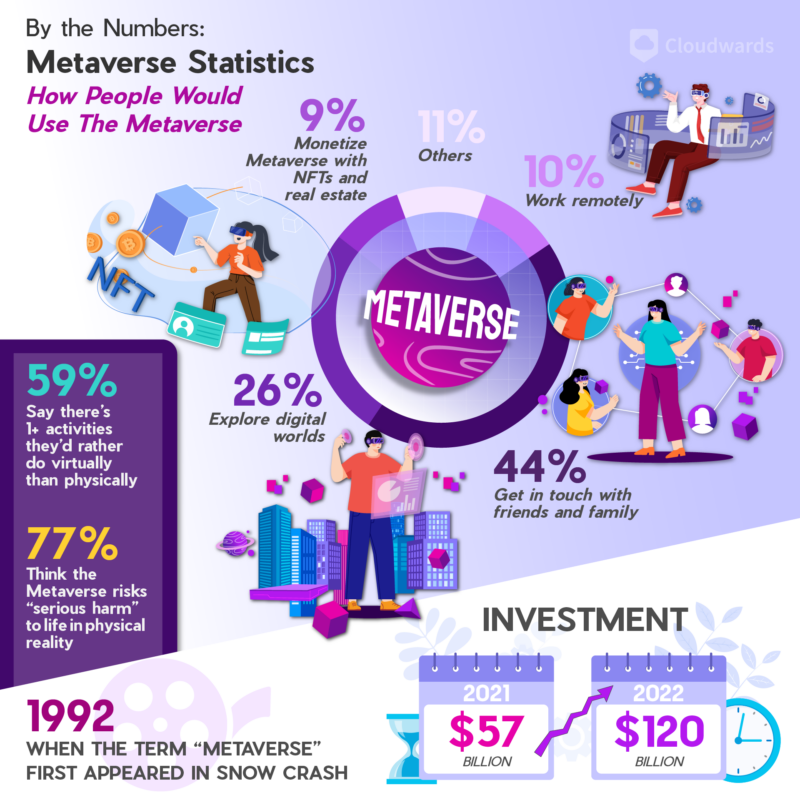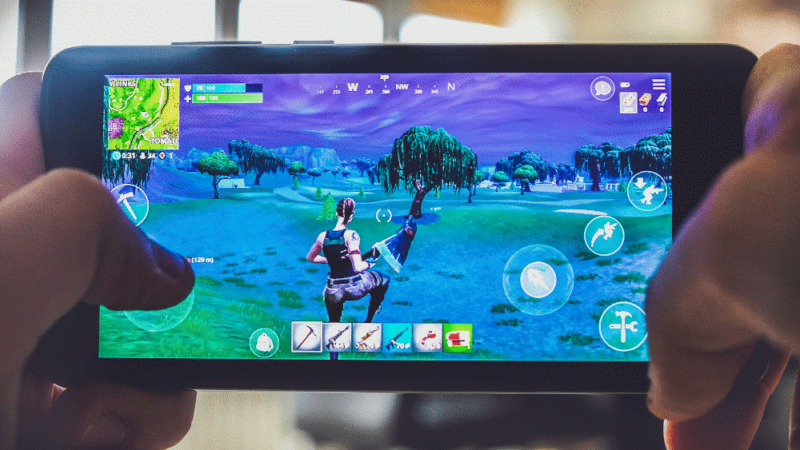Top 20 Metaverse Statistics, Trends & Facts in 2023
The metaverse, a shared virtual reality that turns the internet into an explorable world, is one of today’s hottest technical topics. Despite this, it can be hard to pin down. Our metaverse statistics help you get a handle on this new digital world.
Key Takeaways: Metaverse
- The metaverse has no fixed definition, but most agree it’s a three-dimensional virtual space that adds a visual interface to common online activities.
- Companies invested billions in the metaverse after Facebook threw down the gauntlet by changing its name. However, interest has slackened in 2023.
- Most consumers are interested in the metaverse for social interaction and for doing things they couldn’t do in the real world.
Since first appearing in the 1992 novel Snow Crash by Neal Stephenson, the term “metaverse” has gone from science fiction to reality. The metaverse, a shared virtual reality (VR) where avatars interact in vast digital spaces, could soon become as influential in our lives as the internet — but will it? One look at the metaverse statistics below will show how things are going.
It’s still unclear whether metaverse trends herald the true Web 3.0 or just a passing fad, but with the amount of money invested in developing it — $120 billion in the first five months of 2022 alone1 — we’re at least likely to be hearing about it for years to come. For example, Facebook is so all-in on the concept that it changed its company name to Meta.
We’ve put together a list of metaverse statistics so you can stay informed as this potentially revolutionary concept continues to appear in the media.

5 Key Metaverse Statistics in 2023
- Most potential metaverse users (44%) are most excited to use the metaverse to communicate with friends and family in a more immersive way.
- Three out of four (77%) Americans think the metaverse risks “serious harm” to life in physical reality.
- Google searches for the term “metaverse” peaked in late 2021 with over a million monthly searches, then began to decline significantly by early 2022.
- Metaverse real estate transactions once topped $500 million, but transactions have since slowed down with declining interest.
- Despite the slowdown, the Metaverse market could reach $936.57 billion by 2030, assuming 41.6% annual growth.
What Is the Metaverse?

As a concept just recently plucked from the realms of sci-fi, the metaverse doesn’t yet have a universally accepted definition. People generally agree that it’s a shared, three-dimensional, explorable digital space where a user can exist fully in a way they can’t on the current internet. There’s often a key role for internet of things hardware devices.
Beyond that, lots of questions remain. Is the metaverse a video game, a social network, a chat app, an augmented-reality platform, some combination of the above or something else entirely? Efforts to build the metaverse have been fragmented so far, with corporations unwilling to cooperate on the kind of sprawling shared world seen in movies like Ready Player One.
Metaverse proponents sometimes create confusion by using the term to describe different layers of the experience, from the content to the engines powering it to the underlying concepts like blockchain. Still, with some research, we can tell where the metaverse’s builders are reaching consensus and where they still disagree.
1. No Unified Metaverse Exists Yet
Most people who evangelize the metaverse aren’t referring to a single platform. Instead, they use “metaverse” in the same way people use the term “internet,” to describe a single technology adopted by everyone through global consensus.
No such metaverse exists. Several competing virtual worlds — including Roblox, Decentraland and The Sandbox — can claim to be nascent metaverses, but “the metaverse” implies total interoperability1 — every digital world interacting seamlessly, like unrelated websites on the World Wide Web.
2. Consumers Are Excited to Use the Metaverse for Social Connection
In April 2022, researchers surveyed 2,939 people in Europe and Asia about the metaverse; 59% of respondents said there was at least one activity they’d rather engage in virtually than physically.
Of those respondents, 44% said they were most excited to use the metaverse to get in touch with friends and family in a more immersive way. A further 26% said they were excited to “explore digital worlds,” 10% said they’d use it to work remotely, and 9% were most hyped to monetize the metaverse through NFTs and real estate. There were additional uses, totaling 11% of the total response to the survey.1
Activities Respondents Would Prefer to Do In Metaverse
59% would rather do at least one activity in the metaverse, of them:
44% Talk with friends/fam
26% Explore digital worlds
10% Work remotely
9% Monetize w NFTS/real estate
11% Other
3. Entertainment Has the Biggest Potential to Change
Consumers expect the metaverse to impact entertainment more than any other sector, according to research by Wunderman Thompson, with 90% of survey participants believing interactive experiences will develop far beyond just video games.3
As an example, the shared PlayStation Dreams universe — normally used to create and share video games — is being used to develop a full-length film. A Winter’s Journey, directed by Alex Helfrecht and starring John Malkovich, is in production with no release date yet.4
4. Metaverse Market: Fashion and Retail May Also Be Impacted
Of respondents who knew about the metaverse, 70% believed that it would be used as a virtual storefront.3 Companies are already building stores in the metaverse, with Nike and Forever 21 opening shops in Roblox and Skechers planning storefronts in Decentraland.
History of the Metaverse

unless you believe PUBG’s numbers.
The metaverse’s journey from concept to plausibility spans decades. It’s still evolving today, as companies try diverse approaches to creating a shared augmented and virtual reality.
5. The First Shared Virtual World Launched in 1978
Multiplayer online gaming is almost as old as the internet itself. In 1979, Richard Bartle and Roy Trubshaw built MUD (Multi-User Dungeon), a text-based game where internet users explored a fantasy world via ARPANET.6 MUD can be called the first online RPG, and thus the ancestor of games like World of Warcraft, which themselves spawned the metaverse concept.
6. The Term “Metaverse” First Appeared in 1992
Snow Crash, the 1992 novel by author Neal Stephenson,7 was also the first time the word “metaverse” appeared in print. Snow Crash tells the story of a shared virtual universe where people go to escape a corporate-ruled dystopia. Other works use similar plot points, including the novel Ready Player One and the anime series Sword Art Online.
7. Fortnite Is the World’s Most-Used Metaverse
Many shared virtual worlds could be considered examples of the metaverse, from early prototypes like MUD to massively multiplayer online role-playing games (MMORPGs) like EverQuest, Final Fantasy XIV and World of Warcraft. There are also some popular examples like Second Life that aren’t explicitly video games.
Titles like Minecraft and Roblox command millions of users, but the most successful today is likely Fortnite. The battle-royale game not only sees an average of 240 million users every month, but also holds the record for the most concurrent players of any game, with 12.3 million attending a virtual concert in 2020.8
One note: although PlayerUnknown’s Battlegrounds (PUBG), the progenitor of the battle royale genre, posts greater numbers than Fortnite, the figures don’t always line up with observations made by players.8 To be safe, we’re giving Fortnite the title for now.
8. User Interest in the Metaverse Is Declining
As excited as the companies behind the metaverse boom are about its potential, the public may not share their enthusiasm. Google searches for the term “metaverse” peaked in late October 2021, with over a million monthly searches, then began to fall by February 2022.5 At the time of writing, Google interest in the metaverse is only 5% of its peak, perhaps because AI replaced it in the cultural zeitgeist.
Investment in the Metaverse

Much of the recent interest in the metaverse is driven by money. Beginning in 2021, a critical mass of investors began to cite the metaverse as a real business opportunity with enormous potential returns.
9. Metaverse Investment Exploded in 2022
Not only did metaverse-related technology pull a staggering $120 billion of investment from January to May 2022, but that sum is more than twice what was invested in all of 2021. In that year, investors poured just $57 billion into the metaverse.1
Although more than doubling 2021’s investment is impressive, it’s important to note that much of the 2022 sum comes from Microsoft’s proposal to buy video game company Activision Blizzard1, which is partly intended to “provide building blocks for the metaverse.”2 As of August 2023, that deal is still held up due to U.S. antitrust concerns.
10. Facebook Made One of the Largest Metaverse Gambles
Facebook’s actions over the last few years have shown that it may be more bullish on the metaverse than any other company. After officially rebranding to Meta in 2021 and establishing the Reality Labs division to produce metaverse technology, Mark Zuckerberg announced plans to spend at least $10 billion per year on the metaverse.9
Zuckerberg says the metaverse may take 10 years to reach fruition, representing a total investment of over $100 billion. This all-in approach has not been broadly popular. In October 2022, with Meta having lost over 60% of its share price, a prominent shareholder wrote an open letter asking the board of directors to dial back its metaverse investment.10
11. At Least Four Companies Have Invested $1 Billion in the Metaverse
As we stated in statistic nine, Microsoft considers its $69 billion purchase of Activision Blizzard to be an investment in the metaverse.2 However, Microsoft and Meta aren’t the only companies to pour over a billion dollars into their metaverse capabilities.
Epic Games, owner of Fortnite and Rocket League, secured $2 billion from investors to advance its metaverse ambitions, including developments to the Unreal graphics engine.11 Unity, another 3D-rendering engine, spent $1.6 billion to acquire Weta Digital, the New Zealand-based special effects company behind the Lord of the Rings trilogy.12
12. Even Governments Are Getting Involved
In July 2022, the government of Spain allocated $4.1 million to businesses in the European Union whose products involved the metaverse or Web3 and $8.5 million to create video games and metaverse storytelling.21
13. In 2023, Big Tech Pulled Back Investment in the Metaverse
So far, 2023 has been a “hangover” year for the metaverse, as companies and investors began to realize the technology was not taking off as predicted. Both Microsoft and Disney eliminated their metaverse divisions13 as customer adoption and revenue failed to match the high startup costs of the technology.
Even Meta is de-emphasizing the metaverse, despite spending approximately $36 billion on Reality Labs. Zuckerberg told shareholders in March 2023 that generative AI was now his company’s biggest investment, with the metaverse downgraded to one product among many.14
The Metaverse Real Estate Rush

One of the most common methods of joining the metaverse is to purchase plots of land in popular virtual worlds. Metaverse platforms keep the supply of real estate scarce, just like in the real world, in order to drive demand. Ownership of virtual real estate is recorded on the blockchain, making each plot theoretically unique (much like an NFT).
14. Metaverse Users Exchanged $1.4 Billion of Real Estate in 2022
The metaverse real estate market first heated up in 2021, when users of the “big four” platforms (Decentraland, Sandbox, Somnium Space and Cryptovoxels) traded $500 million in virtual real estate.15 Additionally, 2022 was an even bigger year, with $1.4 billion in sales, an increase of about 180%. One sale cost 333 Ethereum (ETH), about $1 million at the time.16
Interestingly, most of the record-breaking sales in 2022 came from new platforms, especially Yuga Labs’s Otherside, which accounted for three out of every four sales.16 Finally, 2021’s big four worlds lost most of their market share as their artificially scarce supplies dried up and trading volume remained low.
15. The Metaverse Real Estate Boom Is Likely Over
Extreme optimism followed the meteoric growth of metaverse real estate, but the market failed to meet projections. Across all of 2022, real estate lost value on every major metaverse platform, even Otherside (which drove the boom to begin with). Decentraland fared best, but still lost about 4% of its cumulative real estate value.16
In another bad sign, trading volumes remained rock-bottom in April 2023, with only about $50,000 in virtual land changing hands each week on Decentraland.17 It’s not so surprising when you consider that 2022 was also the year of the great crypto crash.
Consumer Behavior on the Metaverse

Though businesses have invested an impressive amount of resources in developing the metaverse, a future metaverse is meaningless without customers to adopt the technology. Measuring public adoption of the metaverse can be tricky. However, there are a few conclusions we can draw about the metaverse according to average internet users.
16. The Metaverse Had Over 400 Million Daily Users in 2022
The metaverse hit the milestone of 400 million daily active users (DAUs) in 2022, according to research by the consulting company Metaversed.18 However, that number includes more traditional virtual worlds like Roblox, Minecraft and Fortnite, which collectively account for 385 million users. Blockchain-based worlds like Decentraland account for just 15 million.18
This distinction is important because Web3 technology is key to fulfilling the promise of the metaverse. For example, much of the hype relies on being able to carry assets such as NFTs from one platform to another. The public’s willingness to adopt Web3 concepts can be seen as a proxy for reception of the metaverse as a whole.
17. Three-Quarters of Americans Believe the Metaverse Might Cause Harm
More than three-quarters (77%) of respondents think the metaverse risks “serious harm” to life in physical reality, according to a survey of U.S. consumers by Tidio.19 The most commonly cited fears include loss of physical fitness, addiction to technology and mental health issues like depression and anxiety.
The results weren’t all gloomy, though. In the same survey, 39% of respondents believed the metaverse would allow people to overcome real-world disabilities, and 37% thought it could enhance their creativity.19
How Respondents Believe the Metaverse Would Real Life
77% Serious physical harm
39% Overcome disabilities
37% Enhance creativity
18. People Would Do Things in the Metaverse They Wouldn’t in Real Life
The same Tidio survey asked respondents to name things they would never do in the real world but might be willing to do in the metaverse; 38% said they’d like to try extreme sports, 22% said they’d go big-game hunting, 19% would attend a gladiatorial fight to the death and 17% would consider keeping a virtual harem.19
These figures are less concerning when we remember that the metaverse is a virtual world, and no real people (or animals) would be hurt by these actions. However, 14% of respondents did say they’d engage in hate speech in the metaverse, so the potential for real-world harm still exists.19
Future of the Metaverse

are expected to increase to 936 billion by 2023.
It’s been less than two years since Facebook’s name change made the metaverse a household name, but it feels like longer. Since 2021, we’ve seen the metaverse go from a futuristic trope to a billion-dollar industry to yesterday’s news. The dramatic swings make it hard to see where the metaverse will be next year, let alone by 2030, but we can still try.
19. Forecasters in 2021 Thought the Metaverse Could Be Worth $800 Billion by 2024
Soon after Facebook announced its name change and its intent to rule the metaverse, analysts at Bloomberg predicted that the global metaverse market size could be worth $800 billion by 2024.20 This worth would come from software subscriptions, especially to video games, and advertising revenue.
20. The Metaverse Is Now Forecast to be Worth $936 Billion by 2030
Analysts in the first half of 2023 have made slightly more modest predictions, but still forecast growth. An April report by Grandview Research suggests that the market could reach $936.57 billion by 2030, assuming 41.6% annual growth.21
This report uses a broad definition for the metaverse, including infrastructure, hardware (especially AR and VR headsets), software (both virtual worlds and the tools used to create them) and in-metaverse assets like real estate. According to Grandview, AR and VR devices generate the most revenue for the metaverse, since they’re used in a wide range of industries with simulated reality.21
Methodology and Further Information
We gathered all the information for this article from publicly accessible sources, all of which you can find linked at the end of the page. Feel free to read them over if you want more information on the metaverse. If you’d like to use these statistics in your own work, please credit us by linking to this article.
Final Thoughts: Metaverse Stats
Although the metaverse has faced challenges in 2023, losing investment and being eclipsed by generative AI, proponents still have faith that these are just growing pains. To evangelists, the metaverse is inevitable, even if it won’t be built by Meta. They point to research showing that people want better virtual worlds, and in sectors other than gaming.
Detractors point out that the metaverse has always suffered from a lack of coherence, with the people building it disagreeing about its final form. They argue that the technology is prohibitively expensive for the value it offers. In the end, only the market can prove which side is right.
We hope you’ve enjoyed our list of metaverse statistics. Are you considering joining the metaverse? Are you one of the global users in support of metaverse adoption? Have you invested in the metaverse or in any metaverse projects? Do you think it will stay mainly used by the gaming industry and metaverse gamers?
Let us know what you think of this all and if you’re interested in more statistics, check out our AI writing statistics article. Thanks for reading!
Sources:
- McKinsey: Value creation in the Metaverse
- Microsoft: Activision deal press release
- Wunderman Thompson: New realities
- Collider: A Winter’s Journey
- Google Trends: Metaverse
- Richard A. Bartle: MUD history
- Neal Stephenson: Snow Crash
- Twinfinite: Most-played online games
- The Verge: Facebook spends $10 billion
- Cointelegraph: Facebook investor revolt
- Epic Games: $2B Metaverse investment
- VCcafe: 10 companies investing billions in the Metaverse
- QZ: Companies reversing Metaverse bets
- Insider: Meta cuts Metaverse spending
- CNBC: Metaverse real estate hits $500M
- Parcel: Metaverse real estate report
- The Block: Decentraland plots trading $50,000 per week
- Metaversed Consulting: 400M active users
- Tidio: Metaverse survey
- Bloomberg Intelligence: Metaverse projections 2021
- Grandview: Metaverse market growth and trends


